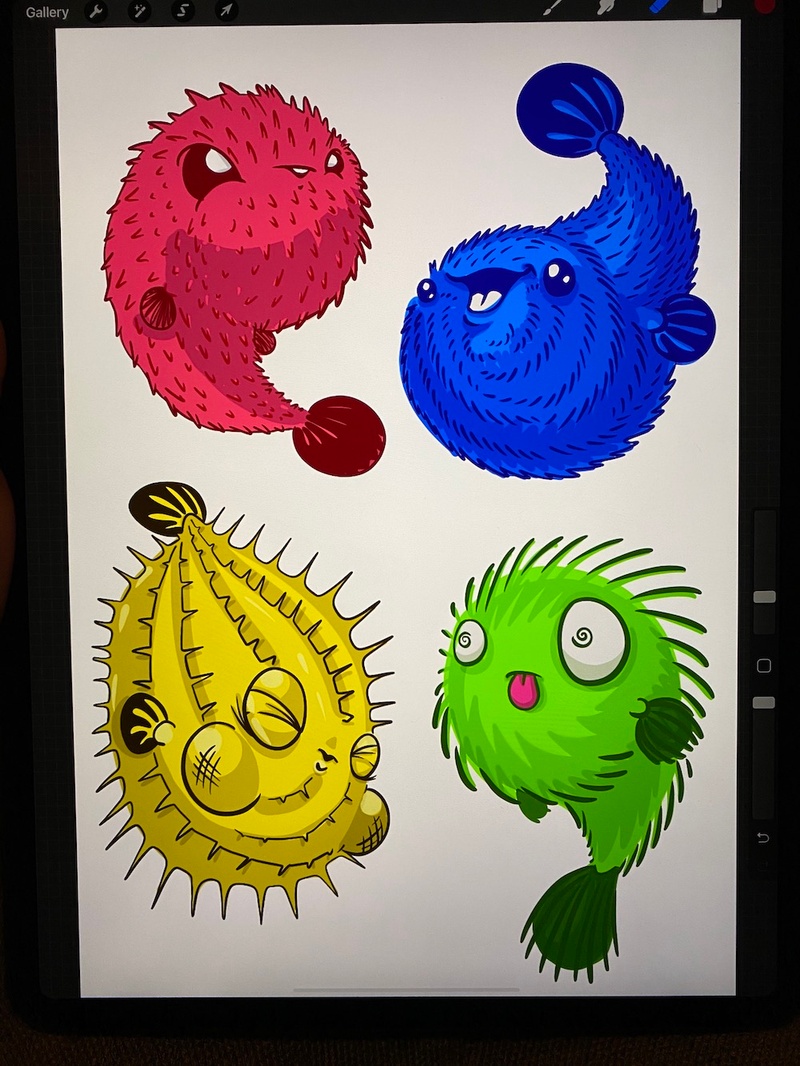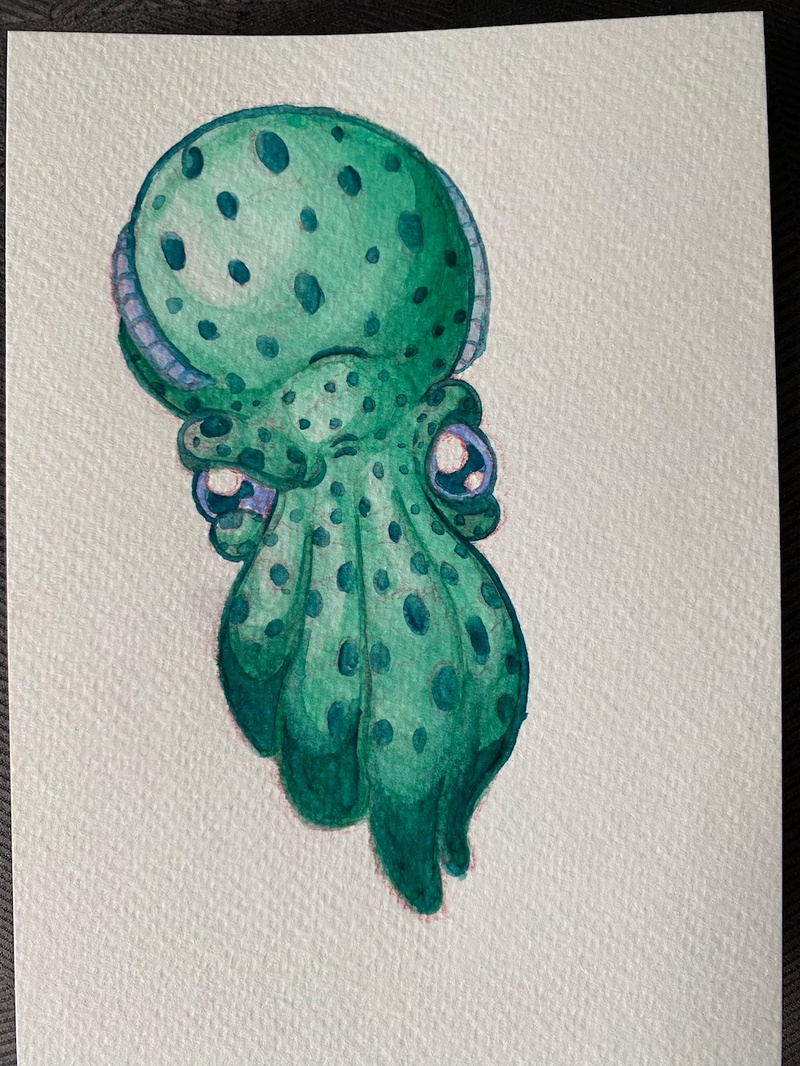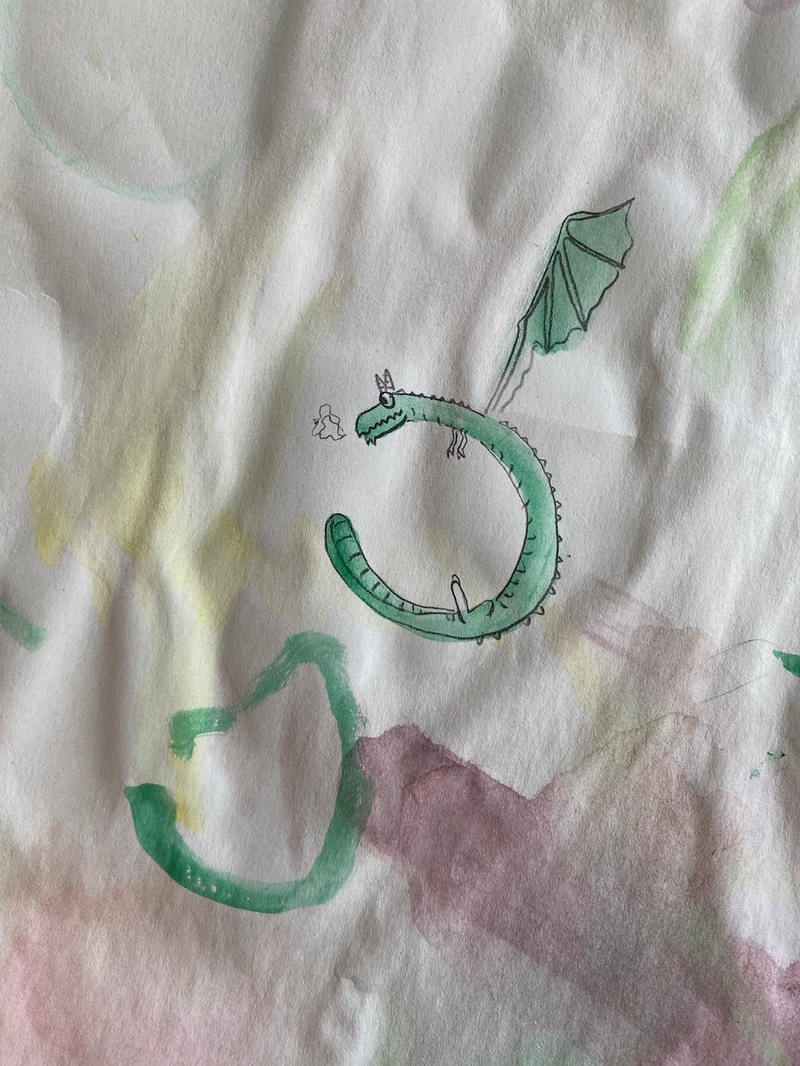How do you balance making time for creative work while being a parent of young children and having a high stress job? How do you avoid burning out?
It was probably in the last year and a half where I ditched balance. It’s a zero sum game, right? You’re using time over here, and you’re balancing against time over here. This constant tension you sit in of, “Am I distributing my time in a way that is equal or balanced?” So I threw that out.
There’s this concept I heard. It’s a simple, human concept, but used in this context it felt new: harmony. Harmony has been what I’ve been chasing. What I mean when I say harmony: Are all the different aspects of my life set into harmony with each other? Is each of them resonating and creating something greater for me? That greater thing for me, personally, is creative work.
It’s always been something, since I was a kid, that has driven me. When I started in the business world, it was my way of being different. Harmony pieces it for me. The beauty is that, I come in every day and the job is to try to make it this much easier for somebody to go and bring their creative work to life. I go home every night and I just struggle. I really struggle to be an artist. I don’t even know if I can call myself that, all the insecurities and everything that comes with it. Then I show up every day and I try to change that. That’s something that resonates deeply.
My wife is a fashion designer. In my family life, the space we live in, the things we do, we’re centering around silly ideas, creative work, projects, stuff like that. When I spend time with my kids, it’s the same thing. I find ways in which these aspects of things that really matter to me show up in my friends, my family, the spaces I occupy on my own personal time. What I found is that, it’s created so much more happiness because I can explore parts of my own identity through aspects of my life that would be meaningful to me. A simple example of that is, we try this thing every Sunday, a family art day. For a couple hours, we clear off the dining table, get the paints out. Everybody does whatever the hell they want to do, but just for that couple hours, that’s all we’re doing.
Do you ever miss family art day, or do you always make sure to have that time?
We missed it for the last couple of weeks. But I’ll say this, I’m always into negotiation. Life is like that. You set up these rules, these rituals, these routines. I think the beauty of it is that none of that stuff is persistent.
You try not to be too rigid.
I’m always in this tension between having discipline and embracing chaos. There’s a routine you want to have and then there’s just the messiness of life. Rather than get too frustrated about it, I use it as an opportunity to reinvent a way to do it.
I’ve had four iterations of our Sunday thing. We used to call it Art Daze, like D-A-Z-E. We would get a bunch of friends together and we’d all sit at somebody’s house or on a rooftop somewhere or in the park, and we would go paint and draw. Then we reinvented it with some small group of friends, just some close friends, and we called it Crafts and Crock. We throw something in the Crock-Pot and we’d all craft for half the day. Now we have the family Art Daze.
Every week is different, but I think intention and finding ways to follow through is the best way to look at it. Otherwise, you languish in the frustration, and you’ll never be motivated to do it. I would say what I’ve learned is that, that half hour or that hour reinvigorates everything else. This is again where that harmony piece is really valuable.
I try to teach my kids that, if you just spend a few minutes doing this for that creative thing, you’ll feel happier about the other stuff you’re doing. Time can so easily slip past. You get so busy, you forget to make time for creative work.
Totally. We’re just in the data with so much work. It’s a coping mechanism to find the thing that’s going to numb your brain, right? Creative work is hard. It’s hard to motivate yourself even though you know it’s good, and it’s something that you want to be doing.
I agree. And, it doesn’t have to be a huge amount of time. You can set aside 10 minutes. If that’s what you have time for, then that’s enough. I think people sometimes psych themselves out like, “I need to have five hours to work on this project.” Just do what you can. It’s not always perfect.
This is how I used to think. I was like, “I just need to be inspired.” I need to find the right moment. And then hopefully when that right moment happens, I’ll magically have four hours right after that moment to just go deep. It’s so infrequent. You open up that sketchbook and you stare this blank page. One of the best things that I learned along the way was, buy the shittiest sketchbook you can find, or find a sketch book, mess it up, and then when you open up a page and you don’t know what to draw, scribble something, just make a scribble, make a line. It shifts your brain into edit mode, which is problem-solving mode. What I found is actually some of the best sketches I’ve made have been totally unintentional. I mean, the squid that so much of my work is centered around, was completely by accident.
You can’t always plan for things. A success is often a complete mistake.
I spent the early part of my career in strategy space. You learn early on that strategy space is: you take in all the variables, you analyze them, think about them, and you come up with some grand concepts. What I’ve learned on the artist’s side of it is, this is just sheer brute force of will, and practice and consistency. I would go to people I really admire and I’d ask them the question, like, “How did you come up with that? What was it?” I’d always be confused by the answers I got, which is they would kind of not have an answer. Or there wasn’t some deeply profound journey. I romanticized them. I didn’t understand that. I found these concepts showing up in life, in different places.
I had a yoga teacher once who used to say this thing every class. At first, it would drive me insane. “Be where you are.” I was like, “What do you mean be where you are? What do you mean? Why would you ever just be where you are? Don’t you want to be more than that?” Right around that third month, I was like, “Oh, shit. Live in this moment, allow yourself to acknowledge and engage in every moment of that you’re in.” It was one of those profound things where it took that pressure off.
It’s such a cliche, but it’s true: “Slow and steady.” If you show up to do the thing every day and you have a day that doesn’t work, you’re like, “All right, whatever. I’ll just do it again tomorrow.” It doesn’t have to be a huge amount of stress; if you consistently do it, it lowers the stress level because you think, “Cool. I did it today. It was okay. I’ll get some done tomorrow, too.” When I was in my twenties, I would think, “Okay, I need to have an entire weekend. I’m going to sit down and get my pen.” Then, like you were saying before, I’d be staring at the blank piece of paper forever.
I used to be the 11:00 PM to 2:00 AM person. Now it’s just 15 minutes sitting at a bench and sketching, starting the day, or a break. I’ve found more progress on really good stuff than I ever have.
Do you miss getting to design as much in your bigger, different role at CEO of Kickstarter?
I do, but I’ll say something I learned from a creative director friend of mien… He’s now one of the heads of design at Airbnb, Alex Schleifer. I remember walking in San Francisco, down the street with him, and being like, “If our jobs as creative professionals goes further and further away from the craft of the thing that we started with, how do you stay sharp? How do you scratch that itch?” He said, “Personal projects.” You just find the space elsewhere.
That’s where my illustration is. I do freelance graphic design projects from time to time, brand stuff. But I do it outside of work because I think that at work, the best thing I can do is cultivate the space where creative people can thrive and foster their ideas. It’s not about me getting in there and doing it myself. I don’t want to be precious about my ideas there. I do appreciate, and I do enjoy the occasional jump in. So much of my learning process is getting hands on. A big shift in learning for me has been how to do that with other people rather than with my own hands.
Do you see the illustrations and the cartooning as something that will grow and culminate in a book or a show or some other larger project? Or is this more something you do because you need to do it and want to keep doing it?
A little bit of both. Completely candidly and honestly, I’m not sure what my end goal is with all of this. I’m scared. I’m scared to put something out. I’m scared to put a mile marker out there. I’m afraid that maybe I won’t get there. It is so much of a passion thing for me. This is only for me, and I love that. I’ve been surprised by how many people it’s resonated with. It allows me to dream that I could do more.
In my heart of hearts, there is the book out there for the collection of drawings, all this. But, I mean, I’m totally honest, I’m just too scared to even allow myself to think that yet. It comes from a place of trying to find confidence in my work. Trying to believe that, something I don’t spend all my time on could be something bigger.
When you landed on the squid, what is it that made you stick with it?
So the squid, as mentioned, happened by accident…the whole sea creatures thing. I remember having a moment where I was like, “This isn’t what I thought I would design.” And I was like, “Well, I could either embrace that or I could fight against it and I could go try to make the thing that I think I should be.” I chose to embrace it. I realized how much of a connection it has to my own identity, how I see myself. There’s a lot of characteristics of squids that resonate with me. The flexibility that they have, to be able to blend into any space. I’m always proud of myself on that. I’ve appreciated any company I’ve ever been to, any friends circle I’ve joined, any space, any traveling we did, I could find myself blending in pretty easily.
On the other end of it, which I think is really profound, when you can blend in wherever you are at a certain point in your life, you ask yourself the question, “Outside of all of that, who am I?” Stepping into a pretty tremendous role like this one, that means a lot to me. The thing I care about has really brought those questions to bear. It stops being about the things I could do to support somebody else’s vision. It really comes down to, “What is the version of the world that I want to see?”
I know, too, that you use to dance quite a bit as well. Where goes that fit into these other parts of your creative life?
If you’re curious, that’s a very important part of being creative. I find that most people who are of that mindset can’t help but dabble in a bunch of things. I gave up on illustration. Then I realized I didn’t know where my outlet for creativity or emotional expression went. Dance for me was the first place I’ve found. People do just feel emotion through a creative outlet.
I believe in our creative potential as individuals. I’ve always been frustrated by the data out there that it’s around kindergarten or first grade where we lose that sense of like creativity, because somewhere along the line we believe, or we convince ourselves, that we can’t draw, we can’t do these creative things. We make a decision. When anybody’s ever said to me that they can’t draw, I’m like, “Well, you could pick up a pencil and you can communicate, but you can lay out an idea.”
When my daughter was born, the thing that my wife and I talked about, that was more important to me than any formal type of education, was that my kids can have an idea, communicate their idea, and know how to make it. They’re going to know how to rally people around it. Whatever tools they need to do that, that’s what I care about. I can give them those tools. Then I feel really confident that I’ve put somebody into the world to maximize their own potential.
Aziz Hasan Recommends:
Letting the weird, odd, and off-balance inspire your journey
The wonderful world of sea creatures
Breaking out of reality through a child imagination
Fucking up your sketchbook to become a better artist - let mistakes foster your creativity
Finding technical references that match your curiosity, like Etherington Brothers’ How To Think When You Draw
This content originally appeared on The Creative Independent and was authored by Brandon Stosuy.
Brandon Stosuy | Radio Free (2021-06-03T07:00:00+00:00) Designer, illustrator, and Kickstarter CEO Aziz Hasan on finding harmony in your daily life and creative work. Retrieved from https://www.radiofree.org/2021/06/03/designer-illustrator-and-kickstarter-ceo-aziz-hasan-on-finding-harmony-in-your-daily-life-and-creative-work/
Please log in to upload a file.
There are no updates yet.
Click the Upload button above to add an update.



